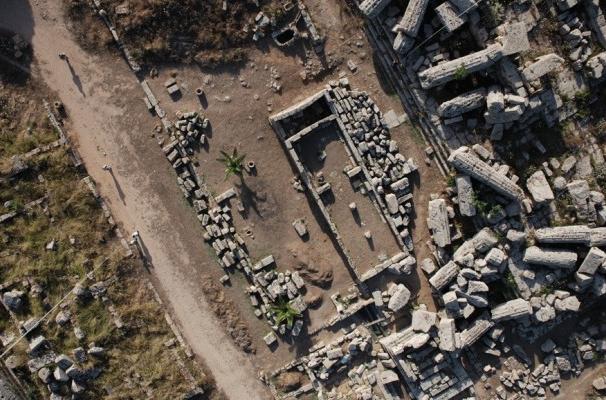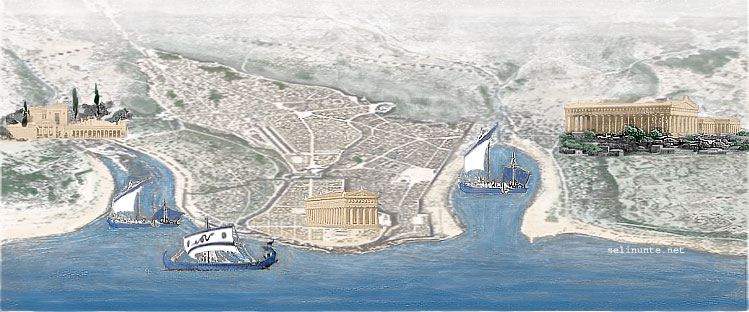Excavation at R temple
During the excavations conducted inside the R temple at the Acropolis of Selinunte, the New York University team led by Professor Clemente Marconi found three spearheads, embedded in the ground. Two of them, the archaeologist explains, are crossed, and this would identify the area on which the city would rise. They date back to the time of the foundation of the city, according to Thucydides, by the settlers from Megara Iblea in 628 BC.
In addition, they found hundreds of objects dedicated to a female deity. She was probably Demeter, the mother goddess of the earth.
The oldest temple
Temple R is located in the southern sector of Megaron, south of temple B.
Built in the 6th century BC, it is the first monumental temple in Selinunte. It is also one of the earliest examples of Greek monumental architecture in Western Europe.
Columns didn’t surround it and it had a deep pronaos and a cell. Only two columns in the pronaos and a third in the cell supported the roof.
Preistoric finds
The excavations started in 2011 brought to light prehistoric finds, the first in the acropolis of Selinunte. They indicate the presence of a settlement in the Bronze Age. This settlement was probably an important commercial centre as evidenced by the presence of Mycenaean ceramics.
The temple R fell due to an earthquake around the middle of the fourth century. After its collapse the temple was rebuilt but its debris was leveled and not removed. They found three floors.
Most of the finds of the deepest levels consist of votive offerings placed along the walls of the cell. Libation vessels, weapons, figured terracottas. They also found even remnants of ritual meals, mostly pigs offered to the goddess Demeter.
In the lower stratigraphic levels of the R Temple, in 2012, two fragments of aulos were found. This is an ancient musical instrument that was subsequently reconstructed through the use of 3D printing.
A filling in the Hellenistic age perfectly sealed the archaic and classical levels. In this way archaeologists have rebuilt the life of the temple.
Now let us now have a general look at the urban organization of the city
The ancient city
Urban planning
The fertile plains surrounding the city and the natural harbors provided prosperity to the inhabitants of Selinunte. The city became a rich emporium, especially because of trade between the Greek world and the western Mediterranean.
Acropolis stretched out over a limestone rock spur, between the valley of the Selinos River today called Modione and the Cotton River. It stretched north to the hill of Manuzza.
To the west, beyond the Selinos, in the place today called Gaggera, stood the sanctuary of the Malaphòros. To the east, beyond the Cotton, in the Eastern Hillside, there was the sacred area with the great temples E, F, G. Visitors from the sea would see them, so they represented the power of the city and its being Greek.
To the north of the eastern hill, north of Manuzza and north of Gaggera there were Necropolises.
The first Mégaron in the sanctuary of Malaphòros and the temple E1 on the eastern hill were among the first temples built at the end of the seventh century.
Styles
Selinunte has been for centuries, as well as Syracuse, Agrigento and Segesta, a compulsory stage for those travelers arriving to Sicily to admire the ancient sites of Greek and Roman cultures.
Archaeologist Vincenzo Tusa, in 1963, was the Superintendent of the Cultural Heritage of Western Sicily and was the promoter of excavations at the archaeological sites of Solunto, Segesta, Selinunte, Mozia and Marsala.
In fact the Sicilian Region has dedicated the Archeological Area “Cave of Cusa” to him.
Tusa declared that in Selinunte it is possible to follow the Doric style in its evolution.
That is, from the archaic forms of the temple C, with its elongated and narrow cell, the crushed echinus and the terracotta cladding, we go to the canonical forms of the great Temple E. Temple B dates back to the Hellenistic age.
An original artistic language compared to the Greece mother country developed in Selinunte, as well in Agrigento and Siracusa. The architectural language of Selinunte also spread in the Punic world. For example the temple at Mango in Segesta was a classic Selinunte style.
Acropolis
Given the historical events of the Greek city of Selinunte, in the acropolis there are remains of Greek monuments but also Punic readjustments and new constructions.
The acropolis developed as “a network” along two main arteries (9 meters wide) that intersect, intersected in turn by other minor ways.
In fact, at the time of its greatest splendor, Selinunte was inhabited mainly on the plain of Manuzza, in the northern area of the acropolis. The latter was mostly occupied by public buildings.
Through the excavations two periods have emerged in the life and architectural development of the acropolis. A Punic layer of the IV-III century overlaps the oldest Greek layers.
The southern part of the acropolis towards the sea was a sacred area. The area was later occupied by Punic houses and sacred spaces.
There is also an ancient Greek Témenos. Here are also the ruins of the temples O and A. A sort of monumental T-shaped entrance leads into the area occupied by the two sacred buildings.
Then there are the temple C and the temple D.
To the north-east there are the remains of small temples: a four-room oikos and the so-called small temple of the small metopes.
Modest houses from the Punic period overlapped the remains of the sacred buildings. However, it seems that religious rites continued.
South of temple C, there is the Mégaron, one of the city’s oldest temples. Almost on the same axis there is the temple B, in front of which stands a quadrangular altar.
To the southeast is the grandiose portico L shaped, and to the east is the agora of the Hellenistic age.
Baglio Florio Museum
The new Baglio Florio Museum in Selinunte displays the results of the excavations. The great nineteenth-century industrial structure once used for wine production now houses the most recent acquisitions in the archaeological field.
It is especially impressive the oldest Doric architecture, the Temple Y, a peripteral temple of unknown dislocation. Its ruins were reused for the fortifications of the North Gate and now are assembled at the end of the vast hall, framed by transverse arches.

